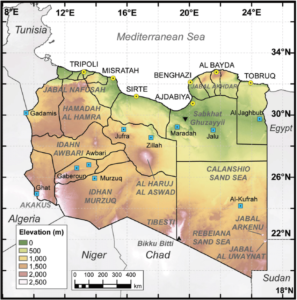| Libya’s geographical position made it occupy a large area of the Sahara, which is considered the greatest natural phenomenon in North Africa, a sprawling plateau and almost flat surface mostly with an average altitude in total between (200-600) meters above sea level, the plateau descends to the north Until it ends at the Mediterranean coast, and gradually ends in some areas, such as in the area around the Gulf of Sirte, and suddenly in other regions so that the northern edge consists of upright or steep cliffs, as in the Green Mountain (Al-Jabal Al-Akhder in Arabic) and the Marmarica Plateau (Batan Plateau in Arabic) in the east, and in the Mountain of Nafusa (Jabal Nafousa or Jebal of Tripoli-Al-Jabal Al-Gharbi in Arabic).In the West, as these heights are only the northern edges that make up the plateau covering most of Libya, the three rims extend parallel to the coast in general, but it overlooks the sea directly in some places while away in other places composed of coastal plains whose breadth differs from one place to another, in the west away the mountain edges away from the coast, forming a vast expansive plain (Jefara plain) and gradually narrowing in the east until the mountain edge meets the sea shore directly at Al-Khoms. In the east, the edge of the Al-JabalAl- Akhder leaves between it and the sea, the vast plain of Benghazi, and approaches the sea as we head north and east until it disappears at Talmita, afterwards, to the Egyptian border, the edge of the Al-Jabal Al-Akhder and El-Betnan plateau directly overlook the sea except in limited locations.
The mountainous areas descend southward gradually, forming the areas of Al-Balat south of Al-Jabal Al Akhdar and Al-Qibla south of Jabal Nafousa as transitional areas between the northern mountains and the desert area, not only in terms of terrain but in addition to the manifestations of climate and vegetation, and the Libyan desert area includes a number of terrain features, which differ from each other either in altitude relative to the sea surface, or in the type of formations of the surface of the earth, where there are mountains and basins low and valleys, and vary in their formations from sand to Al-Sirer and Al-Hamada. etc.
Libya: Shaded height and relief map. (http://www.ginkgomaps.com/maps_libya.html) (https://ar.wikipedia.org/wiki/ملف:Libya_Topography.png)
In the light of the previous general explanation, Libya can be divided into the following terrain sections:
1-Coastal Plains Region
2-Northern Mountain Region (Jabal Nafousa, Al-Jabal Al-Akhdar)
3-Transitional Regions (Sub-Saharan Region)
4- Inland Region (Desert, Inner Mountains and Oasis).

https://www.researchgate.net/figure/Elevational-map-of-Libya-showing-the-major-features-of-the-country-Yellow-circles-major_fig9_320853495
Physical map of Libya (https://www.ezilon.com/maps/africa/libya-physical-maps.html)
|